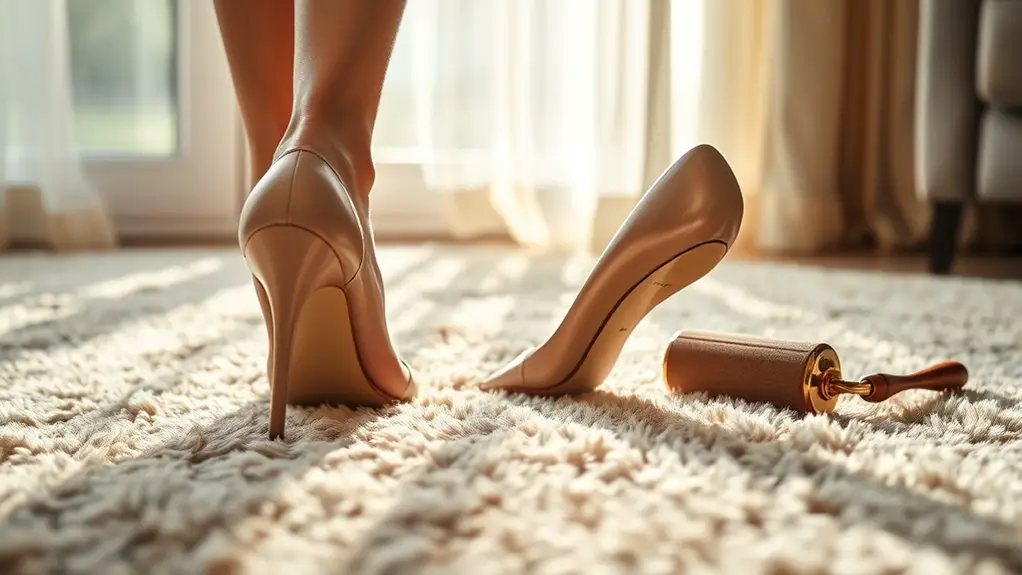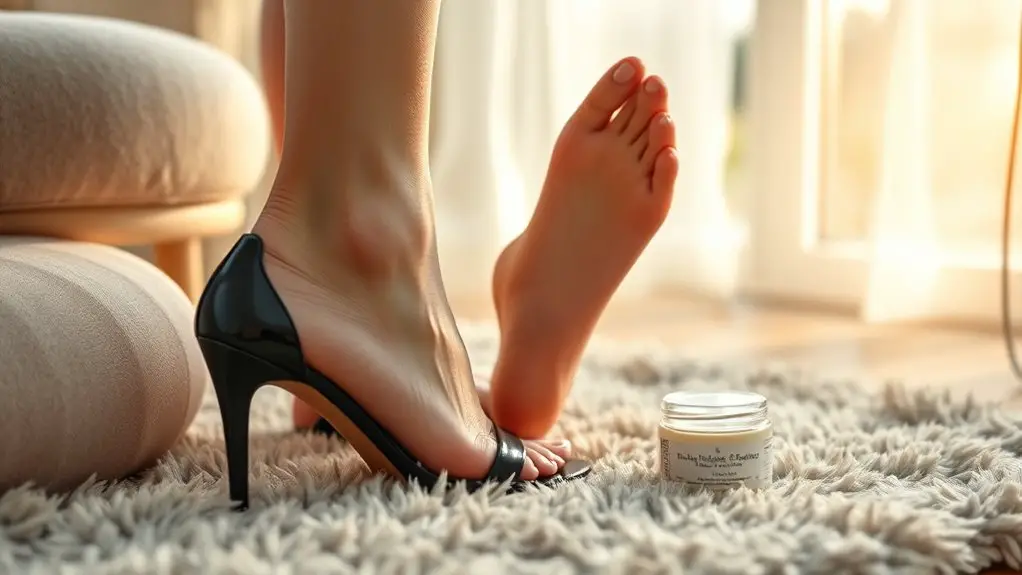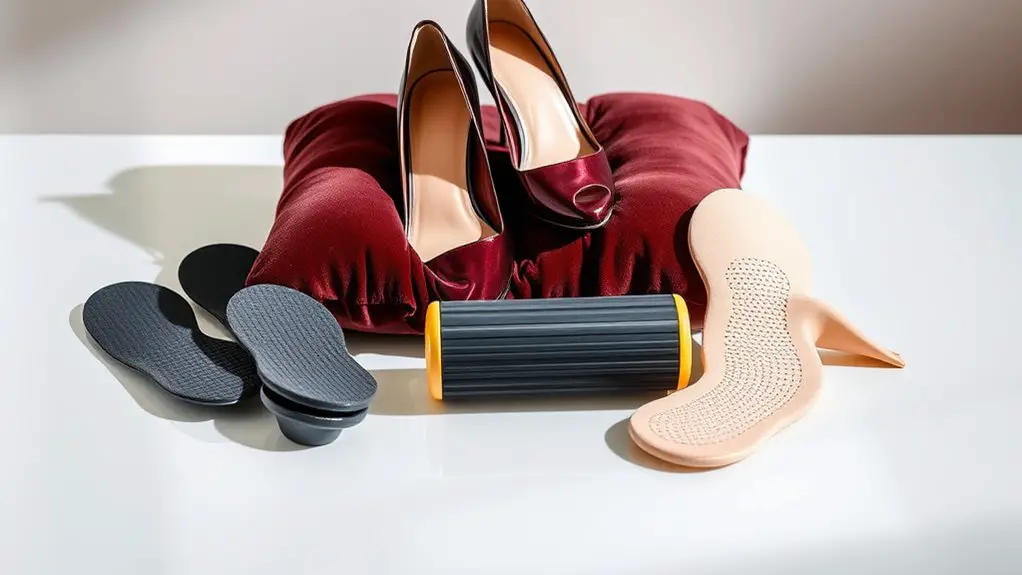To prevent heel pain from wearing high heels, choose lower heel heights (1-2 inches) for better comfort and posture. Opt for supportive features like cushioned insoles and adequate arch support to distribute your weight evenly. Practice proper techniques by ensuring a good fit and shifting your weight to your heels while walking. Strengthen your feet and ankles with regular exercises, and don’t forget to give your feet breaks to recover. There’s more to learn about maintaining foot health while wearing heels.
Choose the Right Heel Height

When it comes to preventing heel pain, choosing the right heel height is vital. Research indicates that lower heel heights, typically around 1-2 inches, provide better foot comfort and reduce strain on your feet and lower back. Higher heels can shift your weight forward, increasing pressure on the forefoot and leading to pain and discomfort. If you prefer a bit of elevation, consider a moderate heel that balances style with functionality.
Also, be mindful of the occasions when you’ll wear your heels. For prolonged wear, opt for lower heels that promote better posture and stability. Remember, an ideal heel height combines aesthetics with practicality, ensuring you don’t compromise foot health for fashion. Listening to your body is essential; if you start to notice discomfort, it might be time to reassess your choice of heel height. Prioritizing foot comfort can greatly enhance your overall experience in high heels.
Opt for Supportive Features
Supportive features in high heels can make all the difference in your comfort and foot health. When shopping for high heels, look for styles that provide adequate arch support. This can help distribute weight more evenly across your feet, reducing strain and the risk of pain. Cushioned insoles are another essential feature; they absorb shock and add extra comfort, especially during prolonged wear. A well-cushioned insole can prevent the development of calluses and blisters, making your experience more enjoyable. Additionally, consider heels with a wider toe box, which allows your toes to spread naturally and reduces pressure. Remember, a little extra attention to these supportive features can go a long way in preventing heel pain. By prioritizing comfort and support, you’ll not only look fashionable but also keep your feet healthy and pain-free.
Practice Proper Footwear Techniques

Choosing high heels with supportive features is only part of the equation; how you wear them also plays a significant role in preventing heel pain. First, guarantee a proper heel fit; your shoes shouldn’t be too tight or too loose, as this can lead to discomfort and instability. A snug fit allows for better control and reduces the risk of blisters.
Additionally, prioritize heels with adequate arch support. This feature helps distribute your weight evenly, alleviating pressure on your heels and preventing pain. When walking, try to shift your weight to your heels instead of the balls of your feet, which can help minimize strain.
Lastly, take breaks throughout the day to rest your feet, and consider alternating between high heels and more supportive footwear. By practicing these techniques, you can enjoy your stylish heels while reducing the risk of heel pain.
Strengthen Your Feet and Ankles
Strengthening your feet and ankles can considerably reduce the risk of heel pain associated with high heels. Engaging in regular foot exercises enhances your ankle stability and improves overall foot health. Here are some effective exercises to incorporate into your routine:
- Calf Raises: Stand on the edge of a step and slowly raise and lower your heels to strengthen your calves and improve ankle mobility.
- Foot Taps: While seated, tap your toes on the ground repeatedly to strengthen the intrinsic muscles of your feet.
- Ankle Circles: Sit or stand and move your ankle in circular motions to enhance flexibility and stability.
Give Your Feet a Break

While it might be tempting to stay in your high heels throughout the day, giving your feet a break is essential for preventing heel pain. Make it a habit to remove your heels whenever possible, allowing your feet to relax and recover. Incorporating foot massages and stretching exercises into your routine can also be beneficial.
Here’s a simple table outlining effective ways to give your feet a break:
| Activity | Duration | Benefits |
|---|---|---|
| Remove Heels | 10-15 minutes | Reduces pressure on feet |
| Foot Massage | 5-10 minutes | Improves circulation |
| Stretching Exercises | 5-10 minutes | Increases flexibility |
| Walk Barefoot | 10-20 minutes | Strengthens foot muscles |
| Alternate Footwear | As needed | Provides additional support |
Frequently Asked Questions
Can High Heels Cause Long-Term Foot Damage?
High heels can wreak havoc on your feet, potentially leading to long-term effects on foot structure. Over time, improper alignment and pressure may cause chronic pain or deformities. It’s wise to prioritize comfort over style.
What Are Signs of Heel Pain From High Heels?
Common symptoms of heel pain from high heels include tenderness, swelling, and discomfort. You can take preventative measures by choosing supportive footwear, limiting heel height, and incorporating foot exercises to strengthen muscles and improve flexibility.
Are Certain Brands of High Heels Better for Foot Health?
Certain brands prioritize foot health, offering comfortable designs with supportive features. Look for those with cushioning, arch support, and wider toe boxes to help reduce discomfort and promote better foot alignment while wearing high heels.
How Often Should I Replace My High Heels?
If you think your high heels have a longer lifespan than a superhero, think again! Regularly inspect them for wear and tear. Replace them every 6-12 months for ideal shoe care and foot health.
Can Orthotics Help With High Heel Discomfort?
Yes, orthotics can greatly help with high heel discomfort. They provide essential heel support, enhancing comfort and stability. The orthotic benefits include better weight distribution, reducing pressure on your feet, ultimately minimizing pain during wear.



